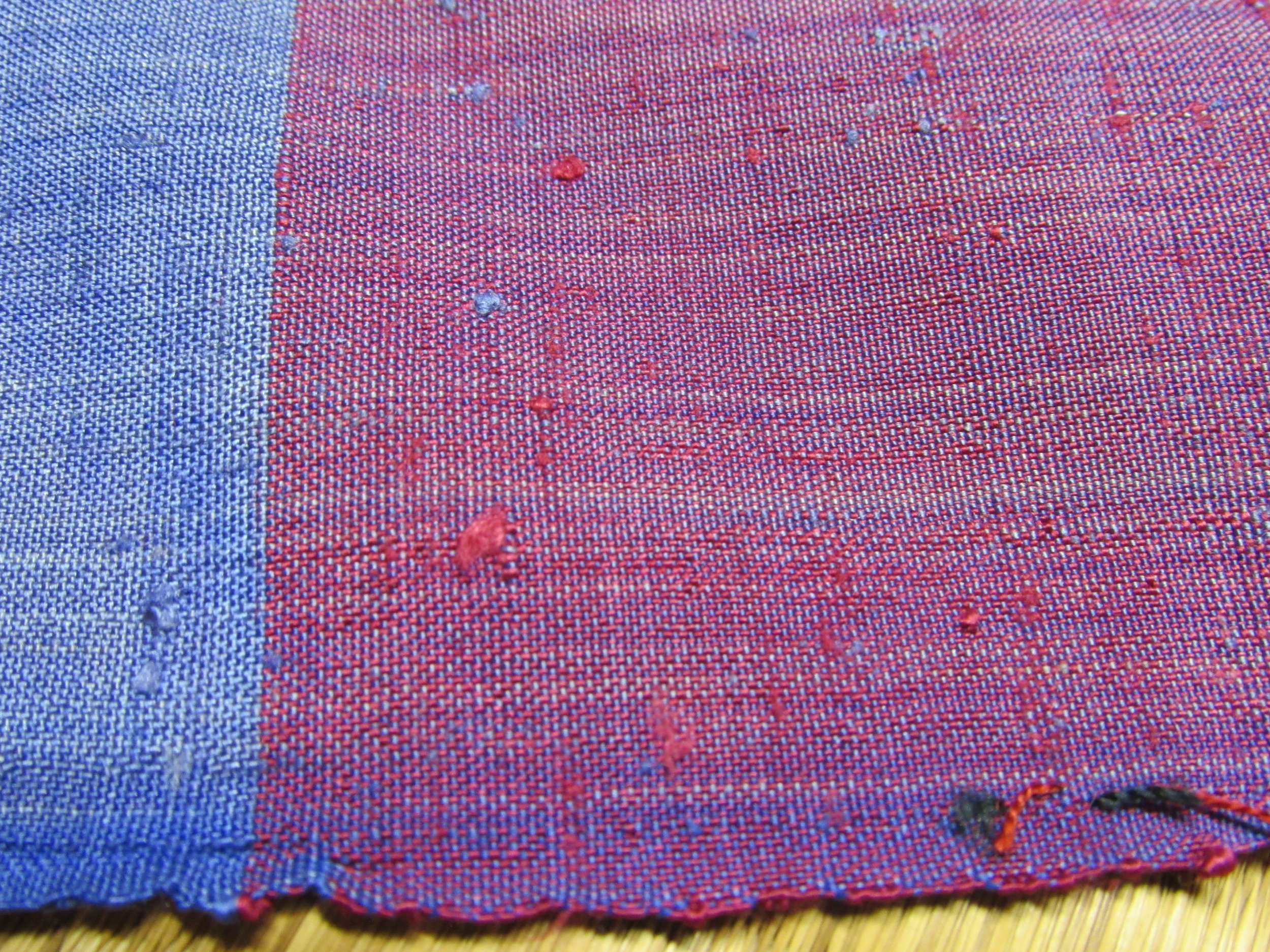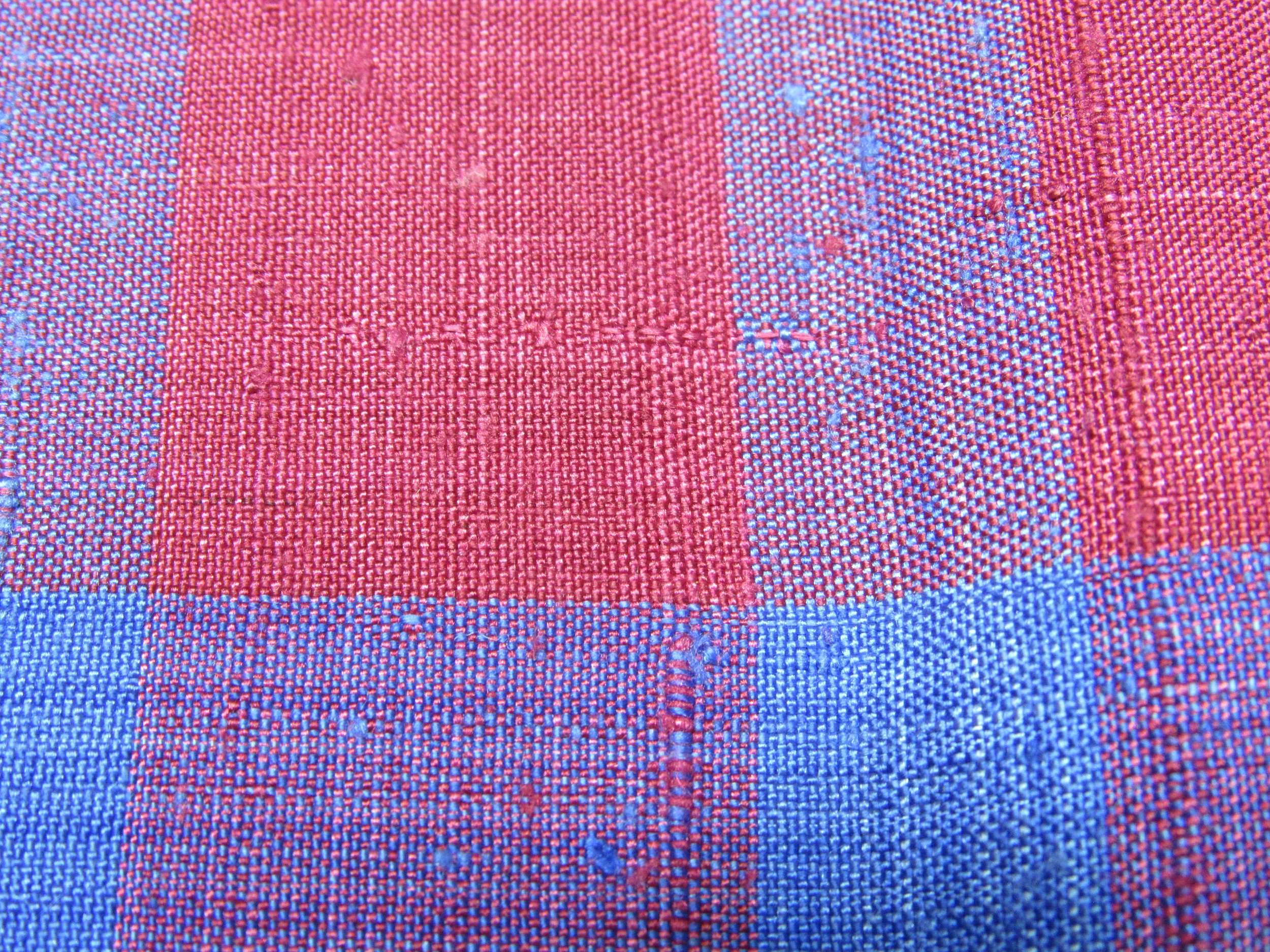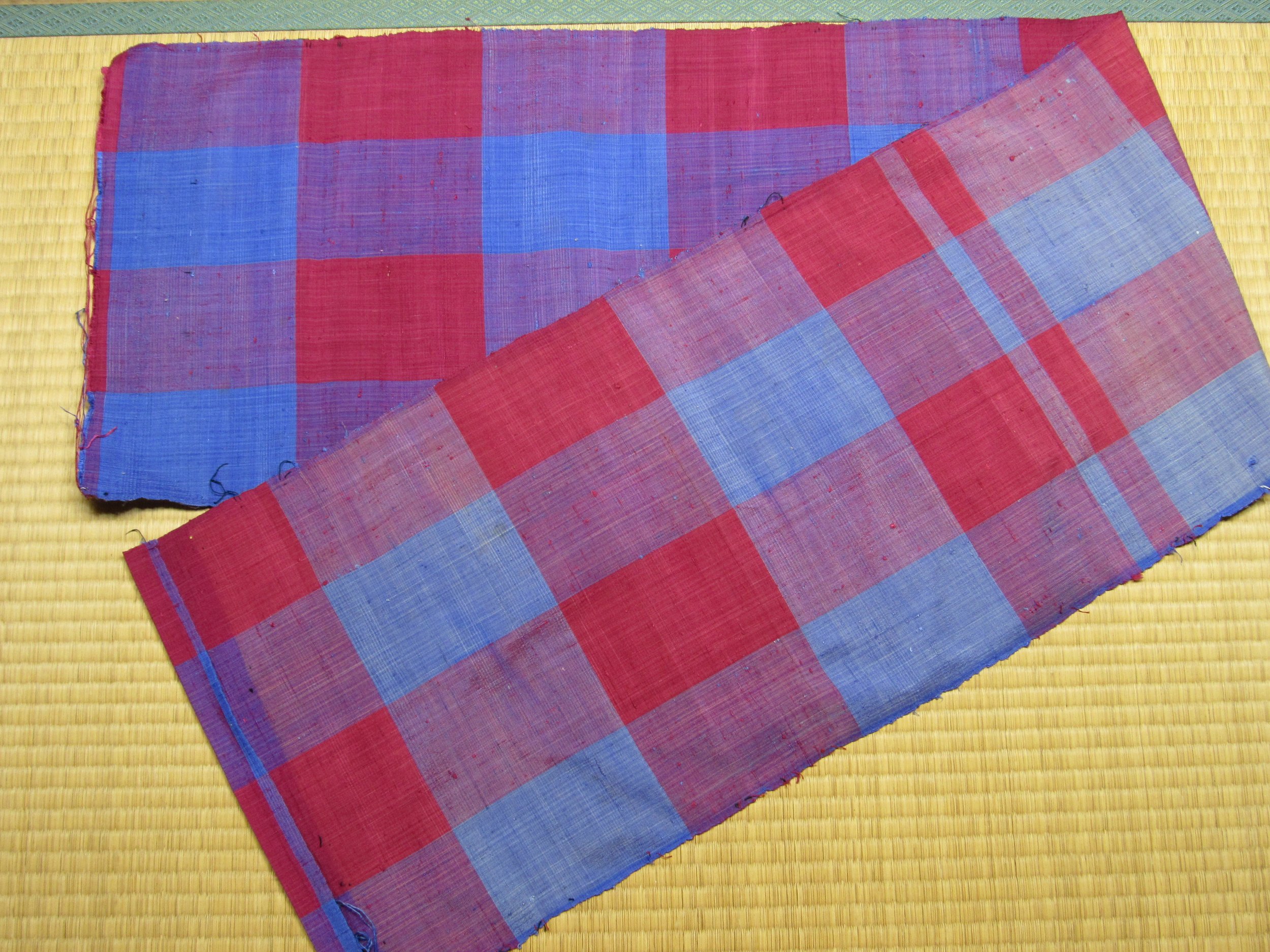 Image 1 of 16
Image 1 of 16

 Image 2 of 16
Image 2 of 16

 Image 3 of 16
Image 3 of 16

 Image 4 of 16
Image 4 of 16

 Image 5 of 16
Image 5 of 16

 Image 6 of 16
Image 6 of 16

 Image 7 of 16
Image 7 of 16

 Image 8 of 16
Image 8 of 16

 Image 9 of 16
Image 9 of 16

 Image 10 of 16
Image 10 of 16

 Image 11 of 16
Image 11 of 16

 Image 12 of 16
Image 12 of 16

 Image 13 of 16
Image 13 of 16

 Image 14 of 16
Image 14 of 16

 Image 15 of 16
Image 15 of 16

 Image 16 of 16
Image 16 of 16

















Antique Silk Tsumugi FABRIC panel - 172 cms
This is a nice long and relatively heavy weave panel of homespun silk fabric from an old kimono. This type of fabric is called ‘tsumugi’, in japanese, or pongee. I write ‘uchiori’, which translates directly to ‘house woven’, and means homespun. This is the heart of mingei. The stripes are not regular, some thinner than others. Somewhat ‘random’ pattern.
Tsumugi originally referred to homespun silk fabrics woven of thicker silk ‘yarns’ which were tightly spun from damaged or irregular silk cocoons (the ones that could not be sold to the filature mills by the silk farmers). The cocoon is carefully teased apart and twisted into a fat string. It was the commoners chance to perhaps wear something fine, or at least make an extra bit of money. The resulting fabric had fibers of varying widths, was slubby from imperfections in the cocoon or areas where two strings were connected, and had a stiffer hand, stiffer than fabrics woven from reeled fibers, cocoons which were unwound, string by string. Tsumugi were some of the first silks allowed to be worn by the peasantry, and were popular because they could be woven at home during winter months. With time, even the middle and upper class folks took notice and tsumugi fabric became a staple of japanese fashion, a stately textile with revered pastoral roots.
This is an older tsumugi silk panel, from Meiji or Taisho era. The design is simple, a very basic plaid. The contrasting colors are stunning and captivating. The red and blue fibers combine to show purple in some areas. There are both red and blue warp threads, and red and blue weft threads. I can see fading on one side of the fabric, and looking at it closely with a jewelers loop, i notice something strange. The blue weft threads have faded with sun exposure, but the very same color blue warp threads have not, even where they come out on the side of the fabric which has faded. hmmm….I wonder why?? I love looking closely at the hand woven pieces. The selvedge is uneven, as hand woven fabrics often are.
This fabric panel is faded on the one side, but the fading is somewhat even, so it could be used that way if you refer those colors. The side which has no fading is very bright, with vibrant colors. The first photo shows both sides. I see one small stain on the faded side which I cannot find when I flip the fabric over. It’s not very noticeable. The last photo shoes it. No holes or tears at all. It is in great condition!
There are a ton of things you could do with part or all of this fabric. The first I would recommend highest is buy it all and make a scarf, a boro scarf. I think you could even use it unfinished, as is, depending on your fashion sense. I would. : ) Or you could add a few patches, make it more boro looking with fabrics and stitches.
You could also, of course, chop it into bits for use in smaller projects of all sorts. Collage, scrapbooking, little sewing projects galore!! Or it could be a part of your rainy day fabric stash. Or a gift for a friend?? and on.....I am sure you have even better ideas.
dimensions
altogether 172 cms long x 37 cms wide
68 inches x 15 inches
107 grams
Share this listing and my shop all over the place, Instagram, Facebook, Pinterest, the local corkboard, tell the cat.
This is a nice long and relatively heavy weave panel of homespun silk fabric from an old kimono. This type of fabric is called ‘tsumugi’, in japanese, or pongee. I write ‘uchiori’, which translates directly to ‘house woven’, and means homespun. This is the heart of mingei. The stripes are not regular, some thinner than others. Somewhat ‘random’ pattern.
Tsumugi originally referred to homespun silk fabrics woven of thicker silk ‘yarns’ which were tightly spun from damaged or irregular silk cocoons (the ones that could not be sold to the filature mills by the silk farmers). The cocoon is carefully teased apart and twisted into a fat string. It was the commoners chance to perhaps wear something fine, or at least make an extra bit of money. The resulting fabric had fibers of varying widths, was slubby from imperfections in the cocoon or areas where two strings were connected, and had a stiffer hand, stiffer than fabrics woven from reeled fibers, cocoons which were unwound, string by string. Tsumugi were some of the first silks allowed to be worn by the peasantry, and were popular because they could be woven at home during winter months. With time, even the middle and upper class folks took notice and tsumugi fabric became a staple of japanese fashion, a stately textile with revered pastoral roots.
This is an older tsumugi silk panel, from Meiji or Taisho era. The design is simple, a very basic plaid. The contrasting colors are stunning and captivating. The red and blue fibers combine to show purple in some areas. There are both red and blue warp threads, and red and blue weft threads. I can see fading on one side of the fabric, and looking at it closely with a jewelers loop, i notice something strange. The blue weft threads have faded with sun exposure, but the very same color blue warp threads have not, even where they come out on the side of the fabric which has faded. hmmm….I wonder why?? I love looking closely at the hand woven pieces. The selvedge is uneven, as hand woven fabrics often are.
This fabric panel is faded on the one side, but the fading is somewhat even, so it could be used that way if you refer those colors. The side which has no fading is very bright, with vibrant colors. The first photo shows both sides. I see one small stain on the faded side which I cannot find when I flip the fabric over. It’s not very noticeable. The last photo shoes it. No holes or tears at all. It is in great condition!
There are a ton of things you could do with part or all of this fabric. The first I would recommend highest is buy it all and make a scarf, a boro scarf. I think you could even use it unfinished, as is, depending on your fashion sense. I would. : ) Or you could add a few patches, make it more boro looking with fabrics and stitches.
You could also, of course, chop it into bits for use in smaller projects of all sorts. Collage, scrapbooking, little sewing projects galore!! Or it could be a part of your rainy day fabric stash. Or a gift for a friend?? and on.....I am sure you have even better ideas.
dimensions
altogether 172 cms long x 37 cms wide
68 inches x 15 inches
107 grams
Share this listing and my shop all over the place, Instagram, Facebook, Pinterest, the local corkboard, tell the cat.
This is a nice long and relatively heavy weave panel of homespun silk fabric from an old kimono. This type of fabric is called ‘tsumugi’, in japanese, or pongee. I write ‘uchiori’, which translates directly to ‘house woven’, and means homespun. This is the heart of mingei. The stripes are not regular, some thinner than others. Somewhat ‘random’ pattern.
Tsumugi originally referred to homespun silk fabrics woven of thicker silk ‘yarns’ which were tightly spun from damaged or irregular silk cocoons (the ones that could not be sold to the filature mills by the silk farmers). The cocoon is carefully teased apart and twisted into a fat string. It was the commoners chance to perhaps wear something fine, or at least make an extra bit of money. The resulting fabric had fibers of varying widths, was slubby from imperfections in the cocoon or areas where two strings were connected, and had a stiffer hand, stiffer than fabrics woven from reeled fibers, cocoons which were unwound, string by string. Tsumugi were some of the first silks allowed to be worn by the peasantry, and were popular because they could be woven at home during winter months. With time, even the middle and upper class folks took notice and tsumugi fabric became a staple of japanese fashion, a stately textile with revered pastoral roots.
This is an older tsumugi silk panel, from Meiji or Taisho era. The design is simple, a very basic plaid. The contrasting colors are stunning and captivating. The red and blue fibers combine to show purple in some areas. There are both red and blue warp threads, and red and blue weft threads. I can see fading on one side of the fabric, and looking at it closely with a jewelers loop, i notice something strange. The blue weft threads have faded with sun exposure, but the very same color blue warp threads have not, even where they come out on the side of the fabric which has faded. hmmm….I wonder why?? I love looking closely at the hand woven pieces. The selvedge is uneven, as hand woven fabrics often are.
This fabric panel is faded on the one side, but the fading is somewhat even, so it could be used that way if you refer those colors. The side which has no fading is very bright, with vibrant colors. The first photo shows both sides. I see one small stain on the faded side which I cannot find when I flip the fabric over. It’s not very noticeable. The last photo shoes it. No holes or tears at all. It is in great condition!
There are a ton of things you could do with part or all of this fabric. The first I would recommend highest is buy it all and make a scarf, a boro scarf. I think you could even use it unfinished, as is, depending on your fashion sense. I would. : ) Or you could add a few patches, make it more boro looking with fabrics and stitches.
You could also, of course, chop it into bits for use in smaller projects of all sorts. Collage, scrapbooking, little sewing projects galore!! Or it could be a part of your rainy day fabric stash. Or a gift for a friend?? and on.....I am sure you have even better ideas.
dimensions
altogether 172 cms long x 37 cms wide
68 inches x 15 inches
107 grams
Share this listing and my shop all over the place, Instagram, Facebook, Pinterest, the local corkboard, tell the cat.